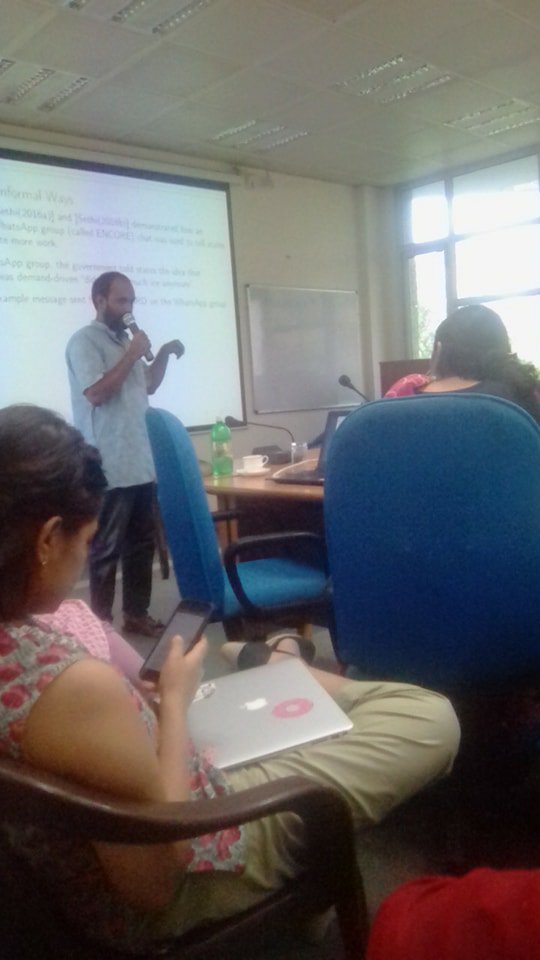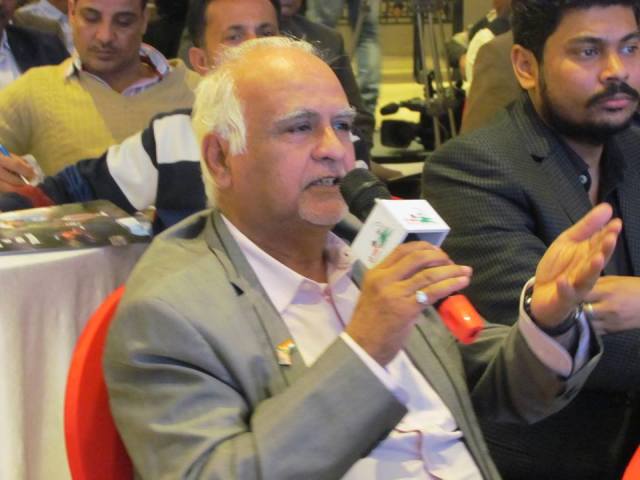Latest track of Meet Bros ‘Nachdi Firaangi’ labelled under ‘MB Music’

The power-packed music directors & singer of Bollywood Industry, the Meet Bros are again all set to keep stage on fire by their latest peppy track ‘Nachdi Firaangi’. As recently, the duos Manmeet & Harmeet Singh were witnessed in New Delhi for the launch of their song. The event took place at Lounge the Lord of the Drinks in Connaught Place. Along with them the talented singer Kanika Kapoor and beautiful Elli EvrRam were also present to grace the event.
While launching the brand new music label ‘MB Music’ with their latest track ‘Nachdi Firaangi’, the Meet Bros also interacted with media peeps and shared the uniqueness of their party number. As the first ever single track is featured under the label of ‘MB Music’, sung by Meet Bros & Kanika Kapoor and it’s the very first time they are together for a single apart from a Bollywood song. The song is packed with clubbing elements and video also featuring the moves of gorgeous Elli EvrRam.
Well, talking about the same, Manmeet stated, “this song is special and unique for us because it’s not for a film, this song is for everyone. It holds dependent music.” Talking about the idea of the song, he said, “One day Kanika came to our studio, she scold us like an elder sister and charged us to make this single, our first single apart from film, she motivated and charged us, then on the same night within one hour we prepared ‘Nachdi Firaangi’. We called Kanika and shared our song and we started working together for the same.” On the other hand Harmeet added, “All the girls who wanna dance, and groove on our latest single can make their videos and forward it to us, we will select one of the best video and when it will get viral, its earning will also be shared with them. So guys keep pouring your videos of ‘Nachdi Firaangi’, this song is just for you all.”
Whereas, Kanika said, “Me and meet Bros are family, we have different equation, I feel highly comfortable and confident while working with them as in studio I can sing openly without any fear in front of them, and we have a great bond.” And, talking about her experience, working in the song Elli EvrRam in Punjabi said ‘Menu Bohot Maza aya.’ Further she added, “It was a wonderful experience, definitely I would love to work again with them. When I got this offer I was so happy and I was happier when I got to know that Kanika Kapoor is also a part of this project, it was really a great time with them all.”
Police Expo 2018:
Police Expo 2018: Predictive Policing & Contemporary Challenges for Indian Police Forces
July 26-27, 2018; BPR&D Hqrs, Mahipalpur, New Delhi
Greetings from FICCI !
I am pleased to inform you that FICCI in partnership with Bureau of Police Research and Development (BPR&D), Ministry of Home Affairs, Govt. of India is organising a two-day Police Expo 2018, with the theme ‘Predictive Policing & Contemporary Challenges for Indian Police Forces’ on July 26-27, 2018 at BPR&D Hqrs, Mahipalpur, New Delhi. The objective of this exposition is not limited to showcasing of technologies & solutions, but to go beyond that, and helpindustry in getting their products & technologies evaluated from an expert Screening Committee for subsequent trails / pilot project.
We are in process of setting-up Bureau’s Expert Screening Committee which will evaluate products and technologiesof the exhibiting companies and facilitate meetings between Industry/ Solution Providers and user organisations(CAPFs & State Police Forces) to undertake field trials and pilot projects for better customisation and adoption.
The programme also aims at creating awareness among young Superintendents of Police from States and Commandants from CAPFs, regarding latest technologies in areas such as Artificial Intelligence; Predictive Policing / Crime Analytics / Big data Analytics; Geospatial Technologies; Cyber Crime; Surveillance Tracking & UAVs; CCTV Equipment, for effective delivery of Police Services to citizens. Some of the focus areas of the conference are as follows :
· Technologies for Predicting Offenders, Predicting Perpetrator Identities & Predicting Crime Victims
· Public Procurement in Internal Security – Way Ahead
· Innovations in Homeland Security – Presentations by Young Minds
· Next Generation Technologies for Homeland Security
· Safe cities V/s Smart Cities
· Talk by visionary Superintendent of Police officers
· Predicting Cyber Crime Against Women
Enclosed are the following files for your reference:
- Brochure of the Police Expo
- Exhibition Form (In case you would like to exhibit during the Expo)
- Product Form (To be shared with the Screening Committee and to be filled by the Exhibiting Companies)
- Delegate Form (In case you would like to participate as a delegate)
There are limited partnership opportunities available; your office may contact us for further information / queries.
Look forward to your kind participation.
Best,
Sumeet Gupta
Senior Director
World Cup fans visiting Qatar will never miss a moment of the excitement
A taste of what to expect when Qatar hosts the world’s biggest sporting event in 2022
Interactive fan zones await visitors at airport, temperature-controlled open air stadium, sports venues & cultural hotspots
Indian visitors to Qatar will never have to miss a moment of the World Cup. With a host of immersive and interactive fan zones across the country, the host for the 2022 tournament is showing off its passion for the sport while giving all a peek of what to expect at the 22nd edition of the most-watched sporting event.
Starting from their arrival at the airport and throughout their stay, the country’s variety of fan zones promise visitors an immersive football experience at different venues across Qatar. To celebrate the world’s biggest sporting event, Hamad International Airport (HIA), Khalifa International Stadium, Ali Bin Hamad Al Attiyah Arena, Katara Cultural Village, as well as malls and hotels have been transformed into fan zones to transfer the atmosphere of the tournament in Russia to people in Qatar.
Right up to the final day of the FIFA World Cup™, Qatar will be abuzz with activities to accompany the live screenings such as football freestylers, football jugglers and impromptu football matches. For a more interactive take on the football frenzy, dies hard fans can take a shot at Robot Goalie, foosball games, virtual football and much more.
Rashed AlQuerese, Chief Marketing & Promotion Officer at Qatar Tourism Authority, commented: “We are very pleased to have so many organisations across Qatar host fan zones for this tournament; it is truly an example of the cross-sector collaboration required for delivering impactful tourism products and events.” He added: “The World Cup’s overlap with the annual Qatar Summer Festival this year gives us the perfect opportunity to build our joint capabilities ahead of Qatar’s hosting of the FIFA World Cup in 2022.”
Airport Fan Zone
In addition to restyling the iconic Lamp Bear area of Hamad International Airport (HIA) to resemble a football pitch, all matches will be broadcast live at three areas close to the boarding gates. Qatar’s award-winning airport and transit hub, fan zone areas are designed to resemble a living room, a stadium and a majlis (a traditional Qatari seating area for receiving guests) to ensure that passengers feel fully immersed in the viewing experience and get a taste of what to expect when Qatar hosts the world’s biggest sporting event in 2022.
Official 2018 FIFA World Cup™ memorabilia will also be on sale at QDF’s stores throughout the airport and shoppers will have the opportunity to take selfies alongside the 2018 FIFA World Cup™ mascot.
This initiative marks HIA’s latest steps on the country’s journey towards the 2022 FIFA World Cup Qatar™. To help prepare Qatar for the 2022 FIFA World Cup, HIA is set to increase its passenger capacity from 30 million passengers per year to a target of more than 50 million per year. During the 2022 FIFA World Cup™, HIA is expected to receive approximately 96,000 passengers per day.
Ali Bin Hamad Al Attiyah Arena
Once in Doha, visitors can check out the fan zone at Ali Bin Hamad Al Attiyah Arena which most famously played host to the World Men’s Handball Championship in 2015. In addition to its enticing free entry, the zone will feature live entertainment and concerts between games, a designated zone for children and families and more than 40 food carts offering distinctly local flavours.
Khalifa International Stadium
Fans can also check out the iconic 2022 FIFA World Cup Qatar venue Khalifa International Stadium.
Following extensive redevelopment, the 40,000-seat stadium reopened in May last year when it hosted the 2017 Emir Cup final. The stadium now features innovative cooling technology for the benefit of players and fans and a world-class LED lighting system, amongst other innovations. Khalifa International Stadium has a rich hosting history, having previously welcomed events including the Asian Games, Gulf Cup and AFC Asian Cup, among other events. In 2019, the stadium will host the 2019 IAAF World Athletics Championships.
Katara Cultural Village
For a more local take on football fandom, visitors can head to Katara where they can enjoy a drive-in viewing experience. The Katara Fan Zone offers fans an opportunity to watch the matches from the comfort of a personal vehicle and with plenty of street food options delivered straight to your window.
Hotels, Malls & Summer Entertainment City
whether at malls or hotels visitors are sure to find a place to kick back and watch a game. Families with young tots can head to Summer Entertainment City which boasts 1,000 m2 of games dedicated to celebrating football.
– Ends –
FIBA Asia Quest 3×3 – India Qualifiers
The Basketball Federation of India is pleased to invite you for the FIBA Asia Quest 3×3 – India Qualifiers to be held at the Sree Kanteerava Stadium (Outdoor) at Bengaluru on June 23-24, 2018.
The FIBA Asia Quest 3×3 – India Qualifiers is a first of its kind FIBA 3×3 event organised under the aegis of the Basketball Federation of India featuring 12 city-based teams in two categories (men and women) representing BFI’s affiliated units.
The winners and runners-up of the FIBA Asia Quest 3×3 – India Qualifiers will represent India at the South Asian Basketball Association (FIBA Sub-Zone) Quest stop. The SABA Quest stop carries a prize money of USD 10,000 with the top teams going on to the Quest Final.
Speaking on the occasion, Basketball Federation of India president Mr. K Govindaraj, MLC said that the FIBA Asia Quest 3×3 – India Qualifiers was the ideal opportunity that the BFI was looking to tip off the FIBA 3×3 movement in India.
“FIBA 3×3 is a great concept is a boon for Indian basketball on many counts. It not only helps us widen the base for basketball thus increasing the popularity of basketball in India, but also is a fantastic opportunity to increase the number of the organisers for basketball events in India,” he said.
“The ultimate aim for BFI is to take the Indian team to the Olympic 3×3 competition.”
Explaining the process further Basketball Federation of India Secretary General Mr. Chander Mukhi Sharma said that the FIBA Asia Quest 3×3 – India Qualifiers is only tipping off of BFI’s long-term FIBA 3×3 project that ultimately targets making basketball a popular sport along with aiming for a place in the Olympics.
“BFI has chalked out a long-term FIBA 3×3 program with a competition structure that will involve more than 500 games across India every year. We do believe that the FIBA 3×3 is certainly the way forward and are certain that it will act as a catalyst in improving the standard of basketball along with increasing the popularity of the sport,” he said.
Games at the FIBA Asia Quest 3×3 – India Qualifiers are scheduled to tip off at 4 pm on Saturday June 23, 2018 and through the whole of Sunday at the Sree Kanteerava Stadium outdoor courts.
Members of the media are cordially invited to witness the proceedings and provide the necessary wide coverage to boost the BFI’s efforts in making basketball a household name.
Naresh — There is a catastrophe happening
Naresh —
There is a catastrophe happening at our southern border right now — and Trump’s executive order doesn’t end this humanitarian crisis.
Thousands of children have been torn from their parents and there is currently no clear plan to reunite the families that have been separated.
It is up to all of us to fight back against the Trump administration’s shameful treatment of children and families. Add your name to say you oppose their cruel separation of families at the border.
I’M IN
Thank you,
I’M IN
Thank you,
Senator Jeff Merkley
Italian Movie, Taranta On The Road

JUN23
European Union Film Festival – Screening of Taranta On The Road
- clockTomorrow at 16:30–18:30Tomorrow · 33-43° Mostly Sunny
- pinIstituto Italiano di Cultura New DelhiItalian Embassy Cultural Centre, 50-E, Nyaya Marg, Delhi, India 110021
Details
Putting a spotlight on the latest European cinema, the European Union Film Festival (EUFF) will screen Italian Movie – Taranta On The Road in New Delhi on 23rd June 2018 @4:30 PM at the Siri Fort Auditorium.
As a special attraction this year, audience, students and filmmakers will get an opportunity to interact with Katarína Krnáčová (Slovakian producer), Paula Ortiz (Spanish Director), Salvatore Alloca (Italian Director), Yannis Korris (Greek Director), Douglas Boswell (Belgium Director) and Ádám Fekete (Hungarian Actor) who are travelling to India for the festival.
Film will be with English subtitles. Entry will be allowed for 18+ and will be on a first come, first served basis.
As a special attraction this year, audience, students and filmmakers will get an opportunity to interact with Katarína Krnáčová (Slovakian producer), Paula Ortiz (Spanish Director), Salvatore Alloca (Italian Director), Yannis Korris (Greek Director), Douglas Boswell (Belgium Director) and Ádám Fekete (Hungarian Actor) who are travelling to India for the festival.
Film will be with English subtitles. Entry will be allowed for 18+ and will be on a first come, first served basis.
For more info, please visit: https://eeas.europa.eu/delegations/india/46492/summer-have-european-adventure_en
Talk on ‘The Crisis of Funds and the Woe of Wage Payment Delays in MGNREGA’

Mahatma Gandhi National Rural Employment Guarantee Act, 2005 is a landmark law which guarantees 100 days of livelihood to rural households. Yet even after a decade of its implementation the Act faces serious challenges to its implementation. While Budget 2017 seemed to have significantly increased allocations to MGNREGA, the Act continues to face a crisis of funds resulting in low wage rates and consistent delay in the payment of wages to beneficiaries. Over the past few years, a team of researchers, including Rajendran, have been measuring the extent of this fund crisis and its impact on wage payments in 10 states. This discussion will share some of their main findings and highlight the reasons behind the delay of funds (including the dynamics between centre-state in determining wage rates), and the impact this will have on livelihood security in rural India.
Dr Rajendran Narayanan is an Assistant Professor in the School of Liberal Studies at Azim Premji University, Bangalore. He completed his Ph.D in mathematical statistics from Cornell University. He has held academic positions in Indian Statistical Institute, Kolkata, Cornell University, and Ashoka University. Since his Ph.D, he has been an intrinsic member of LibTech India, an informal group of researchers and activists that work on questions of transparency and accountability in MGNREGA and the Public Distribution System. The group works with several civil society organisations in Jharkhand, Bihar, Telangana, and Andhra. As a group, LibTech India tries to understand rural citizen experience in times of technology mediated policy initiatives and aim to create bottom-up, people-driven, “Janata Information Systems (JIS)”. The group hopes that this will lead to continuous monitoring of government programmes, leading to more empowerment and better participatory democracy.
 Airbnb was forced to purge 62Ks of its Japan listings, people in new task of sojourn leasing has inks arrangement to apartments and homes for short-term rental thus adds new wave of business in hospitality sector with lending periodically.
Airbnb was forced to purge 62Ks of its Japan listings, people in new task of sojourn leasing has inks arrangement to apartments and homes for short-term rental thus adds new wave of business in hospitality sector with lending periodically.


 Meeting on 26th June 2018 of Federation in Shankar Lodge in East Patel Nagar, New Delhi
Meeting on 26th June 2018 of Federation in Shankar Lodge in East Patel Nagar, New Delhi